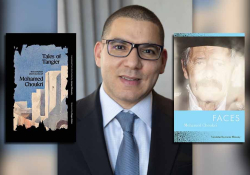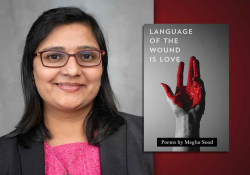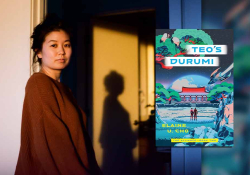Keeping a Critical Eye on Brazil: A Conversation with Emilio Fraia

Emilio Fraia’s Sevastopol, out this summer from New Directions, is the sort of book that beguiles and dazzles in equal measure. Consisting of three disparate stories—of a mountain climber attempting to scale Mt. Everest, a mysterious loner who vanishes into the Brazilian countryside, and an avant-garde production set during the Crimean War—the book is an enigma: Is it a linked collection, a “novel-in-stories,” or something else entirely? Fluidly translated by Zoë Perry, the work came together over an extended period, with sections first published in Granta’s Best Young Brazilian Novelists issue in 2012 and the New Yorker in 2019. Fraia, who lives in São Paulo, spoke over email about Sevastopol, the shadowy realms of fiction, and the “Fora Bolsonaro” movement, among other things.
Anderson Tepper: Emilio, before I ask you about the book, I want to know how things are in Brazil right now and what is happening with the pandemic.
Emilio Fraia: So far, some 560,000 Brazilians have died, the direct result of Bolsonaro’s criminal conduct during the pandemic. He has made countless statements against the vaccine, against wearing masks, and in favor of ineffective drug therapies. At no point during this tragedy has the president uttered a single word of true grief for victims of the virus. And as if that weren’t enough, now his government is embroiled in a bribery scandal involving the purchase of overpriced vaccines, and every day we see clearer and clearer plans for a coup taking shape. It’s frightening to think about the trapdoor opened by Bolsonaro’s government—a man who openly celebrated the dictatorship, torture, and militias—all in broad daylight. It’s frightening that a portion of the population still feels represented by a corrupt mafioso like him. The path Brazil has taken is the worst one possible, and it will take us a long time to recover from the damage.
It’s frightening to think about the trapdoor opened by Bolsonaro’s government.
Tepper: How widespread have the protests been against Bolsonaro, and is the “Fora Bolsonaro” (Bolsonaro Out) movement gathering force? The fact that they happened against the backdrop of the Copa America tournament in July reminded me of the clashes before the 2014 World Cup in Brazil.
Fraia: At the height of the pandemic, Bolsonaro hosted dozens of rallies in support of a coup d’état, a self-coup. They were overflowing with maskless crowds, a macabre spectacle. Now, with vaccinations gaining strength, opposition to the government has taken to the streets. I believe the protests will intensify. Over the last month, Bolsonaro’s popularity has started to chip away—for the first time, the majority in the country now supports his impeachment. And it’s interesting that you mention soccer. The 2014 World Cup marked the beginning of mixed feelings toward the Brazilian team. The yellow-and-green jersey became a symbol for a breed of nationalism that would become identified with Bolsonarism. The recent defeat against Argentina [in the final] seemed to lay bare exactly where Bolsonaro’s authoritarian populism has led us: a small team, with no soul or luster, playing in a Copa America of death, in a tournament nobody wanted to host, put on in a rush in a sad and dying country. It’s not by chance that Neymar, the biggest idol of his generation, is a Bolsonaro supporter.
Tepper: Your new book, Sevastopol, is a collection of three long stories, each very different on the surface. What are the connecting threads that bring them together as a whole?
Fraia: This is a book made up of three stories, to be read as a collection. But it is also a book with a certain atmosphere, themes, and images that run throughout. I’d like the stories to function like images in a poem. Or as if three distinct objects were placed side by side. They are different, but together they seem to form something—a frame, a path, a pattern. As if beyond the voice narrating each of the stories there were something subjective, blurry, creating an effect. A feeling of difference (after all, the stories are independent) but also of closeness (a common tone, a sense of progression, a kind of recurring syntax and vocabulary). For example, in the book there’s always a person telling, imagining, remembering. And the story that’s told, imagined, invented takes the lead and winds up acting as a kind of commentary on the main story—and on the book as well.
Tepper: How were you influenced by Tolstoy’s The Sevastopol Sketches (1855)?
Fraia: The stories in the book are named after months of the year—“August,” “December,” and “May”—and this relates to Tolstoy’s Sevastopol Sketches, which is also made up of three parts: “Sevastopol in December,” “Sevastopol in May,” and “Sevastopol in August 1855.” And although Sevastopol has absolutely nothing to do with any historical work—it’s not a book about war, it doesn’t portray any trenches—there is an atmosphere of conflict and defeat hanging over everything. I really like this one line from The Sevastopol Sketches: “All along, the fighting had worn on in a kind of shadow and unconsciousness, to such a degree that everything that happened seemed to them to have happened elsewhere, at another time, and with other people.” This hallucinatory aspect, this movement of experiences, relates to Sevastopol as well.
Tepper: In an interview with the New Yorker, you talked about other writers who have also had an impact on you—Chekhov, Sebald, Bolaño, Alejandro Zambra, Valeria Luiselli, to name a few. Tell me more about the range of your literary interests and who you’re reading now.
Fraia: I was recently blown away by Pond, the debut novel by English writer Claire-Louise Bennett; The Years, by Annie Ernaux; and Breasts and Eggs, by Mieko Kawakami. I read Optic Nerve, by María Gainza, and really liked it. Panza de burro, by Andrea Abreu, an author from the Canary Islands, is great. So is Feebleminded, by Ariana Harwicz, and Mona, by Pola Oloixarac. I’m anxiously awaiting the new novel by Antônio Xerxenesky, An Infinite Sadness—he’s a Brazilian author who is strangely still unpublished in English. Another young Brazilian writer, Clara Drummond, has just written a great novel, Role Play, that will be published next year. I like Natalia Ginzburg, Yasunari Kawabata, Antonio Tabucchi, Anne Carson, Claudia Rankine, Juan Carlos Onetti, Enrique Vila-Matas, Mario Bellatin, Witold Gombrowicz.
Tepper: One recurring motif in Sevastopol is the existence of stories within stories. In “December,” Lena, whose life has been re-created in a film, explains: “I did what people do all the time. Tell stories, retell them, freeze them in time, try to make sense of them.” Were you especially interested in the idea of how stories are told and by whom?
Fraia: We can learn about the characters’ individual plights—and move a plot forward—in the ways they relate to the stories they hear, invent, or imagine. In the first story, what we know about Lena comes from a kind of narrative short circuit: all of a sudden, there’s a story taking the place of her own story. And we don’t really know which story is her life story, we don’t know who she really is. But, at the end of the day, is anybody anything more than the stories they see and create?
In the second story, there’s one character, Adán, who tells a story, and another character, Nilo, who listens. To what extent might the story being told be more about the listener than the storyteller?
Finally, in the third one, Klaus pursues the life of a Russian painter who lived during the Crimean War, and Nadia is writing about the ups and downs of a man and a woman. These are made-up stories that say a lot about Klaus and Nadia. In the stories written and rewritten by Nadia, she inhabits her own tales, but in an encrypted way, as in a dream. In good fiction, the things that are most important are never said, because they are impossible to say. Words never touch the places where secrets are buried. So the truth can only come out through its transformation into something else. Truth in fiction is this kind of alchemy.
In good fiction, the things that are most important are never said, because they are impossible to say.
Tepper: A version of the second story, “May,” was originally published in Granta’s Best of Young Brazilian Novelists issue. What was the effect of appearing in that issue on you as a young writer?
Fraia: Yes, an initial version of that story was published in Granta. But I wasn’t happy with it. A critic at the time said, “This goes from nothing to nowhere,” and he was right. But I liked some elements of the story, a particular atmosphere, so I decided to rework it, take other paths, sticking with what I liked—and make the story go from nothing to nowhere in a better way. I don’t know if I was successful. With selected texts, like in Granta, there’s often a logic or rationale that governs what gets published or not. And the world that this logic is responding to is a world of realistic narratives or ones based on real stories, with well-constructed characters—the literary tradition of the Anglo-Saxon market. It was a moment when this sort of writing was well received among young Brazilian writers: finally, a generation that knows how to write realistic plots and psychologically believable characters!
But I’m not really sure these are qualities to be celebrated without a critical eye. I think it’s important to try to expand what is sought as a way of narrating, experimenting, trying to connect with what Kafka called the “dreamlike inner life.” Because this is a trap of Anglo-Saxon multiculturalism: foreigners are often incorporated into the hegemonic language (and the market it represents) as nothing more than an accent, as local color or exoticism, enriching it on the surface. Anything outside of that is pejoratively deemed “experimental” or “cerebral.” And so we all—whether we're Brazilian, Chinese, Nigerian, Hungarian—start to write in the same language. There are Brazilian authors who sound like translations of US authors, for example—their syntax, the way they build characters, move the story forward. But I think things are changing, I think now we’re more aware of this kind of thing.
Tepper: I’m curious about your work as an editor at one of Brazil’s major publishing houses, Companhia das Letras. Tell me more about the kind of projects you work on and how you balance your creative life as editor and writer.
Fraia: I work as a literary fiction editor, mainly with Latin American and Brazilian authors, as well as some European and US ones. We just published the first edition in Brazil to include Julio Cortázar’s complete short stories, which made me very happy. I’ve edited authors such as Mario Levrero, Silvina Ocampo, Enrique Vila-Matas, Don DeLillo, George Orwell, Alan Pauls, Roberto Bolaño, Natalia Ginzburg, Regina Porter, among many others. It really is a tricky balancing act. Apart from just general lack of time, the way an editor reads is very different from the way a writer reads. But they’re pursuits that can enrich each other, and in the end, I think I’m fortunate to be able to observe writing from these two positions.
If I were an American editor today, I would definitely have my eye on Brazil.
Tepper: What is your general sense of the literary landscape in Brazil today? Are there ways in which Brazilian writing has changed in the decade since the Granta issue?
Fraia: It’s changed a lot. It’s a much more varied landscape these days. Right now is an especially good moment. Excellent authors are emerging, and writers born in the 1970s and 1980s are publishing their best books. If I were an American editor today, I would definitely have my eye on Brazil.
July 2021
Translation from the Portuguese
















